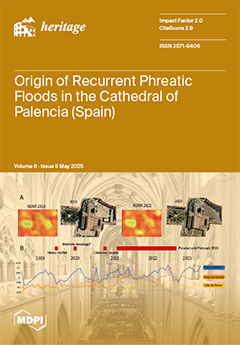The Boronia Ridge palusmont, Walpole, in southern Western Australia, is situated in the most humid part of the State. It was a unique hilltop wetland complex and the only one of its type in the State. On its margins, the area also supports
[...] Read more.
The Boronia Ridge palusmont, Walpole, in southern Western Australia, is situated in the most humid part of the State. It was a unique hilltop wetland complex and the only one of its type in the State. On its margins, the area also supports the ancient sedge
Reedia spathacea, a Gondwanan relict endemic to humid southern Western Australia and the Walpole region and a plant that was ultimately recognised as being of national significance and protected under Australia’s strongest conservation law, the
Environment Protection and Biodiversity Act (1999). However, prior to the geoheritage and biodiversity values of the area being known, in the late 1980s, a pristine scenic area west of Walpole, adjacent to the Walpole River and Walpole Inlet, classified as a Class A national park, was earmarked for urban development, in spite of there being “very little demonstrated requirement for land in Walpole”. This appeared to be as a result of poor land-use planning, since the urbanisation proposed was to be located on the Walpole River delta and wetlands. Urban infrastructures would also impact on adjoining wetlands and the Walpole Inlet System. With new information available in relation to the soils, wetlands, and environmental values of the area, in 1993, community groups and scientists combined, at a public Local Government meeting, to demonstrate that the proposed urban development, referred to as Lot 650, and later Boronia Ridge, with its above-land surface wastewater treatment, was inappropriate, both from an engineering perspective and due to the high conservation values of the area. With the support of the local government of the day and expert scientists who confirmed local concerns, the community engaged in a 7-year conflict with the development proponent, government agencies involved in decision making, and politicians of the day. Ultimately, the use of state-of-the-art science and traditional geomorphic, stratigraphic, hydrological, and geoheritage principles failed to prevent the urbanisation of the area in favour of preserving the whole area as a wetland complex. The following three reasons for this failure are identified: 1. political, rather than science-based decision making, 2. government agencies staffed without the necessary training in biological or earth sciences to make informed decisions, and 3. little attention to environmental concerns due to a bias towards development. Walpole, with its population of 400, moved from a low priority on the wastewater treatment priority list in Western Australia to a high priority on the deep sewerage priority list to accommodate a proposed residential development.
Full article





